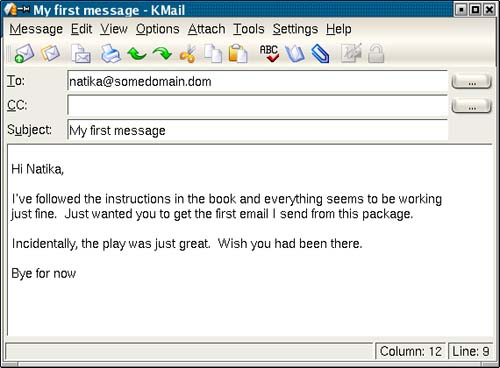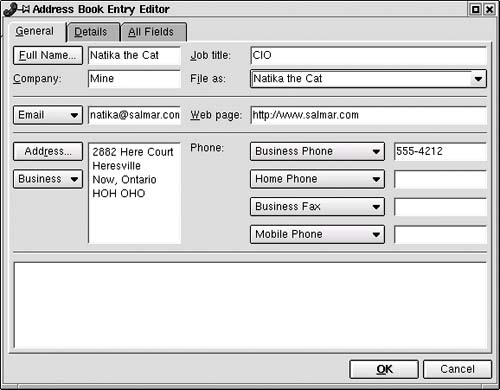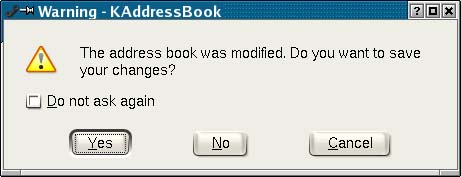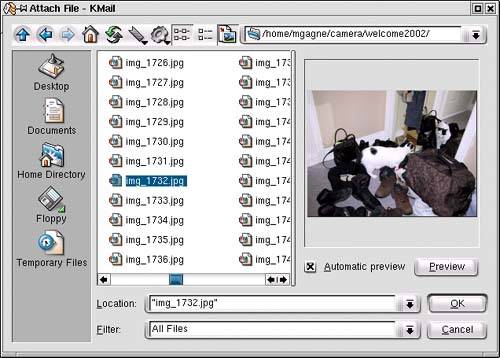Let's Communicate!
Sending messages is easy. Click on the New Message icon?it's the first one at the top left, just below the File menu. If you like the idea of keyboard shortcuts, press <Ctrl+N>, and you'll achieve the same result. The Kmail composer window (Figure 10-5) will appear, and you can start typing your message.
Figure 10-5. Writing an email in the composer window.

I'm working on the premise that you have all sent email at some point; I'll let you take it from there. Fill in whom the message is going to and the subject of your message, then start writing. When you are ready to send the message, click the Send Message icon (directly under the Message menu on the Kmail composer menu bar). For the keyboard wizards out there, try <Ctrl+Enter>.
Receiving Mail
To pick up your mail, click File on the menu bar and select Check mail. You can also use a <Ctrl+L> keyboard shortcut or the Check Mail In icon (Figure 10-6). It is usually fourth from the left in the icon bar.
Figure 10-6. Checking for mail with a click.

Your Little Black Book
The ladies and gentlemen reading this book have by now wondered when I was going to talk about address books. After all, email implies some kind of socializing, whether it be email or personal. When composing an email message (as in Figure 10-5), notice the button with the ellipsis at the end (. . .)?clicking these buttons will bring up the address book, from which you can select whom you would like the message to go out to.
The only problem is that you probably don't have anything in the address book at this moment. Assuming you are starting from scratch, look in the icon bar at the top of either Kmail's main window or the composer window. You should see a little icon that looks like a book. You can also get to the address book by clicking on File on the menu bar and selecting Address Book. When KDE's address book opens up, click on File and select New Contact or click the icon directly beneath the file menu. The keyboard wizards can press <Ctrl+N>. You will see the dialog box shown in Figure 10-7.
Figure 10-7. New contact address book information.

When the Entry Editor appears, add whatever information is appropriate for the contact. The person's name and his or her email address are sufficient if these are all you need. When you are done entering information, click OK. You can add as many names as you want in one sitting but when you are ready to close, you should click that little diskette icon to save your work. If you don't, a warning will appear, suggesting that you do so, as shown in Figure 10-8.
Figure 10-8. Making sure you save the changes in your address book.

Another way to add names to your address book (and by far the easiest) is to take the address from a message that has been sent to you. While you are viewing someone's email to you, right-click on the email address in the From field. A small pop-up menu will appear. Click Add to Address Book, and you are done.
Attached to You . . .
As you sit there writing your letter to your old high-school friend, it occurs to you that it might be fun to include a recent picture of yourself. After all, you haven't seen each other in 20 years. To attach a file, click on the paper clip icon directly below the menu bar. If you have a Konqueror file manager window open, you can also drag an icon from Konqueror into your composer window. In fact, if you have an icon on your desktop, you can drag that into your composer as well, and the images (or documents) will be automatically attached.
If you prefer the menu bar, click on Attach and select Attach File. The Attach File dialog window appears, giving you the opportunity to navigate your directories to find the appropriate file. Directly to the left of the navigation bar, there's an icon that lets you turn the preview mode on and off. This is handy when you are trying to find the right picture to attach. Figure 10-9 shows this dialog in use.
Figure 10-9. Browsing for an email attachment.

Once you have attached a file, it will show up in a separate attachments pane in your composer window. From there you can select those attachments and change your mind. Right-click on the attachment and select Remove.
Send Now or Later
People who aren't online all the time may find that it makes more sense to queue messages, rather then to send them immediately. When the time is more convenient (or you are online), you can send all queued messages. To do this, write your message as always. When you are ready, click Message on the menu bar and select Queue; the messages will be transferred to your outbox folder. You can also click the icon directly to the right of Kmail's Send icon (on the default KDE theme, it looks like a stack of pages). To actually send the messages, dial up to your ISP, click File on the menu bar, and select Send Queued. Note that this menu option will be grayed out if there are no messages in your outbox.
Convenient timing affects more than just when you are online; it also affects when you can finish an email message you happen to be working on. Let's say that you are composing a rather long message to Aunt Sybil, who lives in Australia. After about an hour of typing, you realize that you are supposed to be at your brother's wedding. Looking at your watch, you note that you only have 10 minutes to get to the wedding, and Aunt Sybil's email will certainly take another hour. Because you've already done all this work and you don't want to risk losing it, consider saving your email in your drafts folder.
From the composer window, click Message on the menu bar and select Save in Drafts Folder. When you are ready to resume your email (after the wedding, of course), click on the drafts folder and double-click on your email in process.







